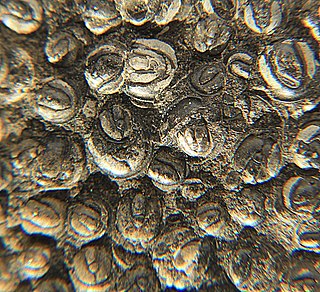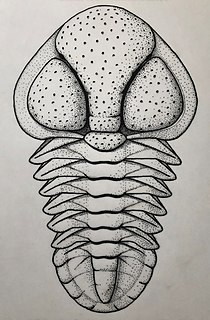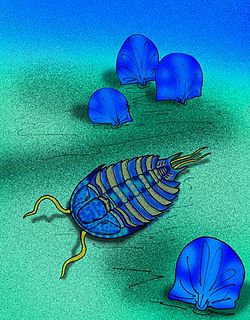
Trilobites are extinct marine arthropods that form the class Trilobita. Trilobites form one of the earliest-known groups of arthropods. The first appearance of trilobites in the fossil record defines the base of the Atdabanian stage of the Early Cambrian period and they flourished throughout the lower Paleozoic before slipping into a long decline, when, during the Devonian, all trilobite orders except the Proetida died out. The last extant trilobites finally disappeared in the mass extinction at the end of the Permian about 252 million years ago. Trilobites were among the most successful of all early animals, existing in oceans for almost 270 million years, with over 20,000 species having been described.

Agnostus is a genus of agnostid trilobites, belonging to the family Agnostidae, that lived during the late Middle Cambrian – early Upper Cambrian. It is the type genus of the family Agnostidae and is subdivided into two subgenera, Agnostus and Homagnostus.

Acontheus is a genus of trilobites belonging to the Family Corynexochidae, Order Corynexochida, and is geographically widespread having been recorded from middle Cambrian strata in Sweden, Newfoundland, Germany, Siberia, Antarctica, Queensland, China and Wales.

Meteoraspis is an extinct genus of ptychopariid trilobites of the family Tricrepicephalidae. The various species lived from 501 to 490 million years ago during the Dresbachian faunal stage of the late Cambrian Period. Fossils of Meteoraspis are characteristic of Late Cambrian strata in North America, though they are found in Late Cambrian strata elsewhere in the world, such as M. nevensis from Victoria Land, Antarctica.

Peronopsis is a genus of trilobite restricted to the Middle Cambrian. Its remains have been found in Asia, Australia, Europe, and North America.

Ptychagnostus is a member of the agnostida that lived during the Cambrian period. Ptychagnostidae generally do not exceed one centimetre in length. Their remains are rarely found in empty tubes of the polychaete worm Selkirkia. The genus probably ranged throughout the water column. It has two glabellar lobes, and three pygidial lobes.
The cephalon is the head section of an arthropod. It is a tagma, i.e., a specialized grouping of arthropod segments. The word cephalon derives from the Greek κεφαλή (kephalē), meaning "head".
Acmarhachis is a genus of trilobite in the order Agnostida, which lived in what are now Australia, Canada, China (Anhui), Kazakhstan, Russia (Kharaulakh), and the US. It was described by Resser in 1938, and the type species is Acmarhachis typicalis.
Lotagnostus is a genus of very small trilobites in the order Agnostida, which lived on the outer continental shelves worldwide, during the late Upper Cambrian. It was described by Whitehouse in 1936, and the type species is Lotagnostus trisectus, which was originally described as a species of Agnostus by Salter in 1864.
Burlingia is a rare and diminutive genus of trilobite, that lived during the early to middle Middle Cambrian. Species assigned to Burlingia have been found in Norway, Sweden, Northern Siberia, and South-eastern China.
Mesolenellus is an extinct genus of trilobites that lived during the lower Cambrian (Botomian), found in Greenland and Spitsbergen.

Lejopyge laevigata is a species of agnostid trilobite belonging to the genus Lejopyge. It existed during the Guzhangian to the Paibian Age of the Cambrian. It has a cosmopolitan distribution and is an important index fossil in biostratigraphy.

Eodiscina is trilobite suborder. The Eodiscina first developed near the end of the Lower Cambrian period and became extinct at the end of the Middle Cambrian. Species are tiny to small, and have a thorax of two or three segments. Eodiscina includes six families classified under one superfamily, Eodiscoidea.

Glyptagnostus reticulatus is a species of agnostid trilobite belonging to the genus Glyptagnostus. It existed during the Paibian Age of the Cambrian. It has a cosmopolitan distribution and is an important index fossil in biostratigraphy. It was characterized by an unusual net-like pattern of furrows on both the cephalon and the pygidium.
Agnostotes orientalis is a species of agnostid trilobite belonging to the genus Agnostotes. It existed during the Jiangshanian Age of the Cambrian. It is an important index fossil in biostratigraphy.

The Peronopsidae comprise the earliest family of the Agnostina suborder. Species of this family occurred on all paleocontinents. The earliest representatives of this family first occur just before the start of the Middle Cambrian, and the last disappeared just after the start of the Upper Cambrian.

Itagnostus is a genus of trilobite restricted to the Middle Cambrian. Its remains have been found in Asia, Australia, Europe, and North America.

Toragnostus is a genus of trilobites restricted to the late Middle Cambrian. Its remains have been found in the United States, Greenland, Denmark, China, Sweden, the Russian Federation, and Kazakhstan. Its headshield and tailshield are almost completely effaced and it has two thorax segments.
Ovatoryctocara is a genus of small corynexochid trilobites from the Cambrian, that lived in what now are Siberia, China, Greenland and Canada (Newfoundland). Ovatoryctocara can be recognised by the combination of the following characters: the central raised area of the cephalon is approximately cylindrical and has two rows of four triangular or round pits. The thorax only has 5 or 6 segments. The tailshield has an axis of 6 to 12 rings, the pleural furrows are well developed and the border is absent or narrow as a hair.
The Burlingiidae constitute a family of trilobites of uncertain affinity, that lived during the Middle to lowest Upper Cambrian. Burlingiids have a cosmopolitan distribution, can be found in deposits that originate from outside the continental shelves, and may have been planktonic. They are characterized by their oval shape, small size, proparian sutures, and non-functional articulations of the thorax. Uniquely the anterior borders of the pleura are raised, and there are between 8 and 15 thorax segments. Burlingiid trilobites have been found in Norway, Sweden, Northern Siberia, Eastern and South-eastern China, Australia (Tasmania), India (Himalayas) and the United Kingdom.










